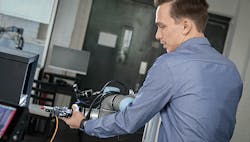Smaller manufacturers often shy away from assembly automation because human workers deal easily with tolerances that present insurmountable obstacles to robots. Additionally, many companies lack in-house robotics expertise and have assembly requirements that aren’t well-served by large, complex, inflexible robots.
While these conventional robots aren’t a good fit for many assembly operations, smaller collaborative robots (cobots) combined with artificial-intelligence-based motion-control systems enable the flexibility that manufacturers of all sizes need to finally automate assembly lines.
Also read: Are AMRs the right fit for your business?
How to get started
Cobots are both affordable and easy to program. Manufacturing engineers are often surprised at how far a worker can get with a first test cobot and a little time to experiment, even minimal robotic experience. Companies with a bit of design know-how may be able to make their own small components, such as fingers for an electric gripper, and get by without hiring a system integrator.
However, precise position can be problematic for cobots. This is especially true when the workpiece has tolerances in shape or position or when it is inserted into a machine that is movable. In these cases, a camera must be used to measure the workpiece or situation. Unfortunately, traditional vision systems are not able to deal with variances. They also need to be calibrated, which is an additional challenge.
Artificial intelligence
An alternative to precisely measuring a workpiece or situation with a camera is real-time control driven by artificial intelligence (AI). This type of system uses a neural network to search for relevant features in the environment—geometric shapes, colors, or surface textures—to ensure correct movement. The AI system uses such features to continuously steer the robot through its path.
AI-driven systems are much more robust and can handle variances in real time that are not accounted for by normal vision systems: Real-time control enables precision better than manual robot programming, and the robot only needs to be shown the target a few times in typically occurring variants; the system does not need to be calibrated. The robot can then adjust movements independently in real time to adapt to its environment. The AI controller derives this motion intuition for the robot from camera images and shown positions, so the robot can deal with unfamiliar situations.
Workstation-based implementation
Behavior-based robot training and AI controllers enable manufacturers to convert assembly robots to new uses locally, making the automation of manual operations more practical. Implementation is straightforward. There is no need to turn the entire production over to robots. Manufacturers can update a single workstation and see results.
Also read: Collaboration requires presence sensing
The costs of collaborative robots, tools and AI control are within the financial scope for projects that must pay for themselves in a few months. Conveniently, these small robots can be deployed temporarily and moved to different locations. Since an AI controller can learn many skills, they make the cobots much more flexible.
AI applications
Cobots and AI-driven control systems are used for handling, assembly and testing tasks. Examples include inserting injection molded parts into fixtures for printing, hanging springs, removing metal parts for weighing, filling holes at an unknown location and leak testing of solder joints.
Pairing a cobot with AI control systems makes it easy to transfer motion know-how from humans to robots. They can be configured directly by the machine operator (Figure 1). Like touchscreens on cell phones, AI provides a natural way to tell cobots what you want them to do.
About the authors
About the Author
Maximilian Mutschler and Matt Jones
Micropsi Industries

Leaders relevant to this article:


